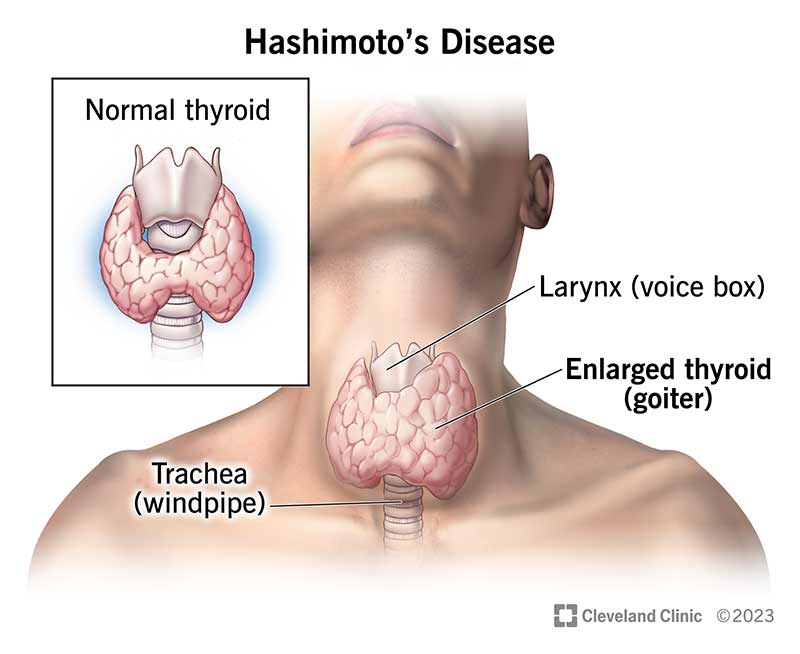
Hashimoto Thyroiditis
Hashimoto's disease is an autoimmune disorder affecting the thyroid gland. The thyroid is a butterfly-shaped gland located at the base of the neck just below the Adam's apple. The thyroid produces hormones that help regulate many functions in the body.
Overview
Hashimoto's disease, also known as Hashimoto's thyroiditis chronic lymphocytic thyroiditis, and chronic autoimmune thyroiditis, is an autoimmune disease that damages the thyroid gland. An autoimmune disorder is an illness caused by the immune system attacking healthy tissues. In Hashimoto's disease, immune-system cells lead to the death of the thyroid's hormone-producing cells. The disease usually results in a decline in hormone production.
Although anyone can develop Hashimoto's disease, it's most common among middle-aged women. It's the most typical reason for hypothyroidism or an underactive thyroid. The primary treatment is thyroid hormone replacement. Hypothyroidism can lead to issues conceiving as well as during pregnancy if left untreated. Fatigue, weight gain, depression, and joint pain are signs of hypothyroidism.
Causes
One common thyroid gland condition is Hashimoto's disease. Although it can happen to anyone at any age, middle-aged women are the ones who experience it most frequently. It is brought on by the immune system's attack on the thyroid gland. The illness starts slowly. It could take months or even years for the condition to be detected and thyroid hormone levels to fall below normal. Those with a family history of thyroid conditions are more likely to have it In rare cases of hormonal issues caused by the immune system. Both type 1 diabetes and inadequate adrenal function may cause it known as Type 2 polyglandular autoimmune syndrome (PGA II). Type 1 polyglandular autoimmune syndrome (PGA I) is where there is adrenal gland dysfunction and fungal infections in the mouth and nails. Other causes include
Parathyroid gland under activity
Excessive exposure to radiation
Exposure to chemical agents
Hormonal changes
Viral infections
Symptoms
Fatigue and lethargy
Enhanced sensitivity to cold
An increase in drowsiness
Skin is dry
Constipation
Muscle weakness
Muscle aches tenderness stiffness
Joint discomfort and stiffness.
Inconsistent or excessive menstrual bleeding
Depression
Problems with memory or concentration
Goitre (thyroid swelling)
A puffy face
Fragile nails.
Hair loss
Increased tongue size
Ayurvedic View
Galaganda- Here gala refers to neck and ganda is a swelling resembling shape of button, filled bladder etc, the disease in which there is swelling in front of the neck hanging pendulously like a srotum, either big or small in size or without swelling. Dosha involved is aggaravated vata ,kapha dosha which does vitiation of medas (fat tissue), as pitta is not involved, there is no suppuration of the swelling, this is hashimoto thyroiditis, due to autoimmune condition and hormonal imbalances- (hypothyroidism). Ayurveda's approach is to correct agni (metabolism), bring doshas back to prakruta awastha (balance state), reduce the symptoms and prevent the complications by ayurvedic panchakarma treatment and treatment done to improve the function of the thyroid gland.
Ayurvedic Treatments
Udhwarthanam Bashpa Swedanam Kashaya dhara Virechana Lepanam Thalapodichil Vasti Nasyam Dhomapanam Shirodhara
Naturopathy Treatments
Spinal bath Enema Steam bath Sun bath Mud therapy Neck Packs Reflexology Magneto therapy Acupuncture Manipulative therapy Diet therapy Clinical yoga Cyclic meditation Mind sound resonance technique
Hashimoto Thyroiditis
Treatment for
DISCLAIMER: Listed treatment details are only for information purposes. Treatments and duration may vary depending on numerous factors. Treatments for your condition may not be limited to this list.






















